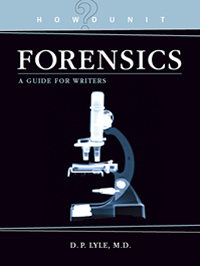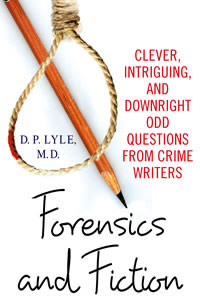Sunday, March 30: The A.D.D. Detective
FORENSIC ERRORS
by Leigh Lundin
If you’ve ever wondered if I buy books mentioned in my column, I do– within the past two weeks, I picked up a dozen mentioned in Criminal Brief plus two forensics books. I was disappointed in both of the latter, so when I saw Doug Lyle had a new forensics book coming out, I asked him to participate in today’s column.
 D. P. Lyle, MD is the Macavity Award winning and Edgar® Award nominated author of the non-fiction books, Murder and Mayhem, Forensics For Dummies, and Forensics and Fiction as well as the thrillers, Devil’s Playground and Double Blind. His next book is Howdunnit: Forensics: A Guide For Writers, from Writers Digest Books, due May, 2008.
D. P. Lyle, MD is the Macavity Award winning and Edgar® Award nominated author of the non-fiction books, Murder and Mayhem, Forensics For Dummies, and Forensics and Fiction as well as the thrillers, Devil’s Playground and Double Blind. His next book is Howdunnit: Forensics: A Guide For Writers, from Writers Digest Books, due May, 2008.
Doug is a practicing cardiologist in Orange County, California– those books that look like Modern Library Classics behind him are actually cardiology books. Dr.Lyle’s worked as a story and technical consultant with many published authors and with the writers and producers of several popular television shows, including Law & Order, CSI: Miami, Diagnosis Murder, Monk, Judging Amy, Cold Case, Peacemakers, House, Medium, and 1-800-Missing. Be sure to visit his web site, The Writers’ Medical and Forensics Lab.
Top 10 Writers’ Medical and Forensic Mistakes
by D. P. Lyle, MD
The Quick Death: No one dies instantly. Well, almost no one. Instant death can occur with heart attacks, strokes, extremely abnormal heart rhythms, and cyanide and other “metabolic” poisons. Cyanide and a few other chemicals prevent the body’s cells from using oxygen so death arrives in a hurry. But trauma, such as gunshot wounds (GSWs) and blows to the head, rarely cause sudden death. Yet, how often has a single shot felled a villain? Bang, and he drops dead. In order for that to occur, the bullet would need to severely damage the brain, the heart, or the cervical (neck) portion of the spinal cord. A shot to the chest or abdomen leads to a lot of screaming and moaning, but death comes from bleeding and that takes a while.
The Pretty Death: I call this the “Hollywood Death.” Calm, peaceful, and not a hair out of place. Blood? Almost never. The deceased is nicely dressed, lying in bed, make-up perfect, and with a slight flutter of the eyelids if you look closely. Real dead people are ugly. I don’t care what they looked like during life, in death they are pale, waxy, and gray. Their eyes do not flutter and they do not look relaxed and peaceful. They look dead.
 The Bleeding Dead: Your detective arrives at a murder scene a half hour after the deed. Blood oozes from the corpse’s mouth and from the GSW in his chest. Tilt! Dead folks don’t bleed. You see, when you die, your heart stops and the blood no longer circulates and it clots. Stagnant or clotted blood does not move. It does not gush or ooze or gurgle or flow or trickle from the body
The Bleeding Dead: Your detective arrives at a murder scene a half hour after the deed. Blood oozes from the corpse’s mouth and from the GSW in his chest. Tilt! Dead folks don’t bleed. You see, when you die, your heart stops and the blood no longer circulates and it clots. Stagnant or clotted blood does not move. It does not gush or ooze or gurgle or flow or trickle from the body
The Accurate Time of Death: Determining the time of death is neither easy nor very accurate. It is always a best guess and is stated as a range and not an exact time. Yet, how many times have you seen the detective or the ME confidently announce that the victim died at “10:30 last night”? I always wonder exactly how he made this determination. Was it rigor mortis, body temperature, or lividity? Was it the presence of absence of certain bugs? Of course, the problem is that none of these is accurate. In real-life the ME would say that death likely occurred “between 8 p.m. and midnight.” But that might make him appear wishy-washy and Hollywood likes its heroes to be smart. Smarter than they could possibly be.
The One-punch Knockout: You’ve seen and read this a million times. The hero socks the bad guy’s henchmen in the jaw. He goes down and is apparently written out of the script, since we never hear from him again. It’s always the henchmen, because the antagonist, like most people, requires a few solid blows to go down. Think about a boxing match. Two guys that are trained to inflict damage and they have trouble knocking each other out. And when they do, the one on his back is up in a couple of minutes, claiming the other guy caught him with a lucky punch. Listen to me. Only James Bond can knock someone out with a single blow. And maybe Mike Tyson. Your car-salesman-turned-amateur-sleuth cannot.
The Disappearing Black Eye: If your character gets a black eye in Chapter 3, he will have it for two weeks, which will likely take you through the end of the book. He will not be “normal” in two days. A black eye is a contusion (bruise). It is caused by blood leaking from tiny blood vessels, which are injured by the blow. It takes the body about two weeks to clear all that out of the tissues. It will darken over two days, fade over 4 or 5, turn greenish, brownish, and a sickly yellow before it disappears. On a good note, by about day 7, your female character may be able to hide it with make-up.
 The Quick Healing: This is a corollary to the above. If your character falls down the stairs and injuries his back, he will not be able to run from or chase the bad guy or make love to his new lover the next day. Give the guy a few days to heal and make him limp and complain in the interim. If he breaks an arm, he’ll need 4 weeks minimum.
The Quick Healing: This is a corollary to the above. If your character falls down the stairs and injuries his back, he will not be able to run from or chase the bad guy or make love to his new lover the next day. Give the guy a few days to heal and make him limp and complain in the interim. If he breaks an arm, he’ll need 4 weeks minimum.
The Untraceable Poison: No such thing. With fancy equipment like Gas Chromatography-Mass Spectroscopy (GS-MS) virtually any chemical can be identified. The combination of these two tests gives a “chemical fingerprint” of the compound in question. The trick is to disguise the death to look like something else so that an expensive and time consuming full toxicological examination will not be done.
The Instant Athlete: Your PI drinks too much, smokes too much, and eats donuts on a regular basis. He will not be able to chase the villain for 10 blocks. Two on a good day. If he must, then make him capable. Remember “Babe” Levy (Dustin Hoffman) in Marathon Man? He had to run for his life as Dr. Christian Szell (Sir Laurence Olivier) and his Nazi bad guys chased him endlessly. But earlier in the film we learned that he ran around the reservoir in Central Park everyday. He could run for his life.
The Instant Lab Result: The world is not like CSI. They get results in a New York minute. In the real world the same test can take days, even weeks. A preliminary or presumptive test may be done quickly, but most confirmatory testing takes time. And the coroner will not likely release a report until the results are confirmed.





















Speaking of forensics, remember Quincy, ME? Apparently, all is not well in NBC’s medical center. Jack Klugman is suing the network to force them to open their books. Executives claim the show has lost $66 million as of 2006, which might seem more like fictional accounting than reality show.
Thanks to Dr. Lyle with the answers needed when I am plotting murder and death — and thanks to Leigh for sharing him with us.
Hi Leigh and Dr. Lyle,
This is terrific information for mystery writers. Dr. Lyle, thanks for taking the time to give us the information needed to make our work more realistic.
Terrie
Before he moved, I knew a forensic entomologist who determined time of death (like that guy on CSI). He was extremely interesting.
Thanks for the sources.
This is great information. Many thanks!
Thanks! This sort of information is fascinating to us who don’t deal with it in real life! If there isn’t a “Medical stuff for Dummies” blog, there oughta be!
Doug’s the guy who provided me with the murder weapon in my Treviscoe novel. I asked him if he could recommend a poison that could be identified in an autopsy without the benefit of such techniques as Gas Chromatography -Mass Spectroscopy, since it had to be done in 1768.
Doug suggested two such substances, one of which was utterly perfect: cantharin, or Spanish fly. In the 18th century, it was called “tincture of cantharides”.
If that book ever sells, Doug’s name will be prominently displayed on the Acknowledgements page. He’s pretty used to that by now!
James, I just added the Doctor’s page to my “favorites.” Oh, and let us know when the novel comes out!